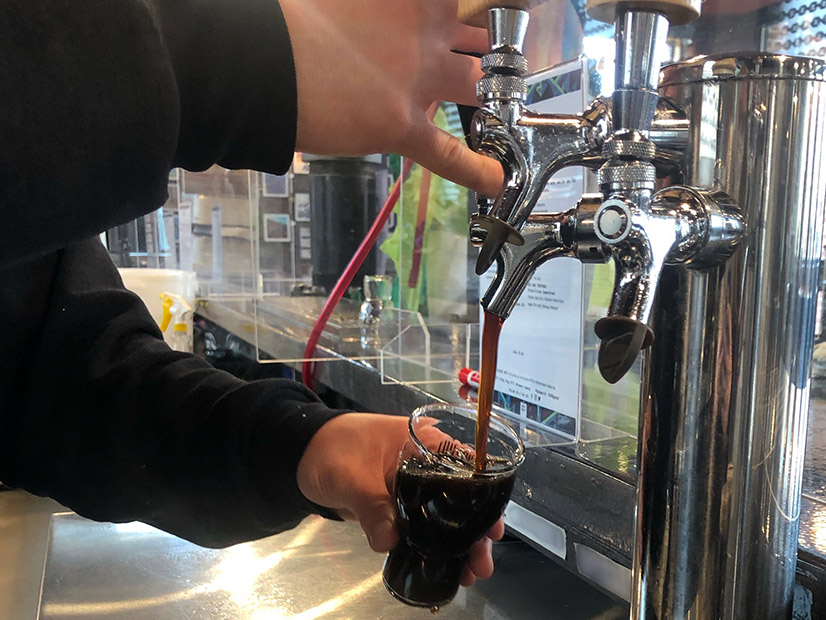The supply chain for independent breweries is rife with opportunities to build sustainability, according to the New York State Pollution Prevention Institute at Rochester Institute of Technology.
Upstream supply chain raw materials processing is “most responsible for the industry’s impact on the environment,” said Trish Donohue, sustainable supply chain program manager at the institute.
“Glass and can manufacturing, barley production and malting make up more than 75% of the upstream environmental impact of brewing beer,” Donohue said Tuesday during the NY Sustainable Brewery Summit.
New York has 484 breweries, according to the New York State Brewers Association. Despite the pandemic, the state’s number of breweries grew by 26 in 2020, Executive Director Paul Leone said at the summit. And before the pandemic, the state’s industry averaged one brewery opening every seven days.
Research has shown that consumers believe beer from independent “craft” breweries is “more sustainable,” Donohue said. But just because consumers believe it, that doesn’t make it true. Brewers need to build sustainability into their supply chains and communicate to customers how they are doing it.
Since only about 20% of a brewer’s impact on the environment comes from inside the brewery itself, the brewer needs to engage with partners in the supply chain to understand and — potentially — influence their sustainability practices, Donohue said. To help brewers with this process, the institute has developed a sustainable supply chain code of conduct for breweries and an e-book on how to build a sustainable supply chain.
Barley Agriculture
Traditionally, brewers source barley that comes from a grower and goes to a malt house for germination before it is shipped to the brewery for in-house beer production.
With the bulk of barley crops grown in the U.S. originating from the Northwest and north-central states, Donohue said GHG emissions from barley transportation can account for a significant environmental impact in the supply chain.
“Local sourcing closer to New York or within New York state may help reduce the impact of transportation and provide more supply chain transparency between the barley grower and the malt house,” she said.
Options for New York’s brewers to access local malted barley are opening up. According to Cornell University, some New York malters have committed to buying New York barley for their production streams. Murmuration Malts in Bloomfield, New York, for example, only sources its barley from farmers in the Finger Lakes region, according to the company. The company also has made a commitment to limiting its environmental impact through sustainable practices.
The Empire State Development Council, in collaboration with members of the brewing industry supply chain, have set a barley production target of 30,000 acres in New York by 2023.
Brewers also can watch for other sustainable practices, such as organic production and no- or low-tilling planting, by barley growers, according to Donohue.
Malting
The process of malting requires electricity and natural gas to warm steeping water and control air temperature for germination, drying, curing and roasting.
One metric ton of malt produces GHG emissions equal to an internal combustion passenger car that runs for 700 miles, according to Donohue. In addition, malting uses significant amounts of water. A 2006 study estimated that 1,320 gallons of water were used to produce one ton of finished malt.
“There is no industry standard or certification for a sustainable malt house, but many more houses now demonstrate an awareness of their role in supporting sustainability and reducing environmental impacts,” Donohue said.
Signs of a sustainably operated malt house include a published sustainability program and availability of USDA certified organic malt, she said.
Packaging
There is no clear pathway for sourcing sustainable packaging for beer. The most sustainable option, according to Donohue, is to sell beer in a reusable glass pint from reusable steel kegs. The next best option is to use reusable, refillable glass containers.
“Reuse is the name of the game when it comes to offsetting the impact of packaging,” Donohue said. And choosing a sustainable packaging option requires understanding where there are trade-offs in the production of packaging.
Those choices may come down to the brewer’s preference for recyclability, recycled content or reduction of GHG emissions, she said.
Aluminum cans, for example, are made from bauxite ore that is mined outside of the U.S. The environmental footprint of a can, therefore, includes a heavy percent for overseas transportation. Mining operations result in clear-cutting of land, and there are additional emissions from production and transportation within the U.S.
Glass bottle production, on the other hand, has high GHG emissions from the energy needed to melt silica.
Bottles that are made from recycled content use less overall energy than manufacturing of virgin aluminum cans, but bottles are heavier than cans and require more energy for transportation. The overall environmental impact of the two options is equal, Donohue said.



